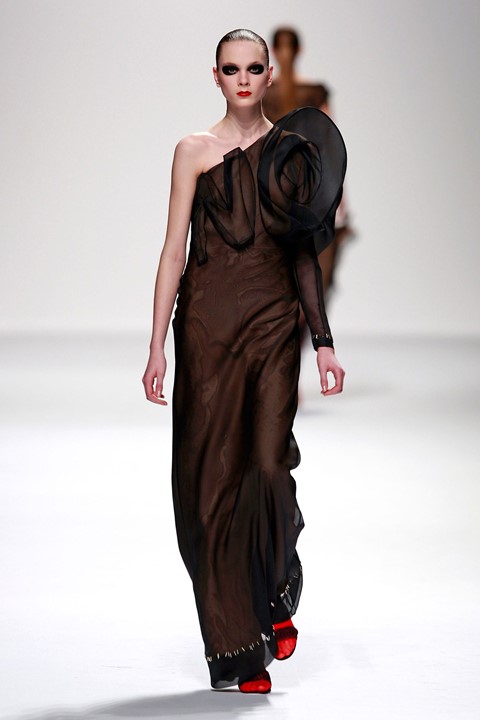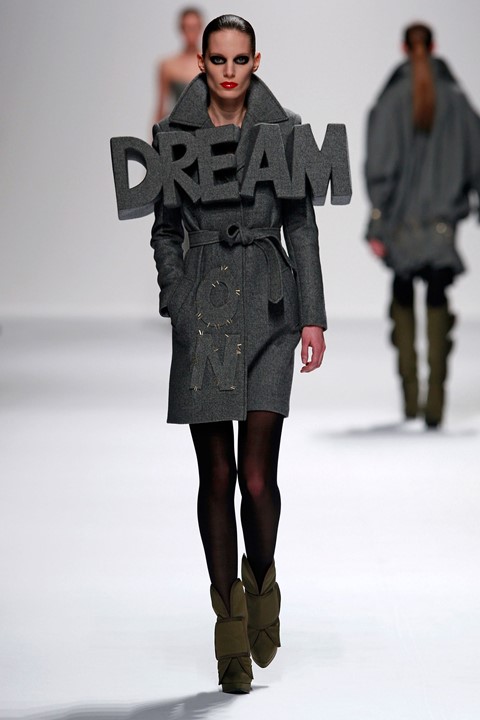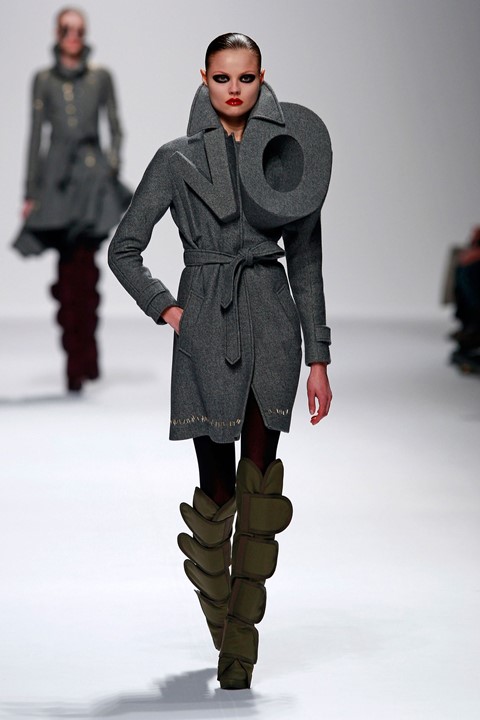Defiance against the fluctuating state of commerce and creativity was written all over the duo's A/W08 collection, their sentiments spelled out on elegant winter separates, writes Osman Ahmed
There’s something slightly unnerving about Viktor Horsting and Rolf Snoeren, the Dutch childhood friends-turned-design duo. Often both outfitted identically, their faces framed by matching spectacles, the creative partners have staged theatrical fashion shows that sometimes veer towards performance art in their unadulterated presentation of concepts and ideas – by which I mean the kind of clothes that one can afford to make if you are the proprietor of some of the best-selling perfumes in the world. Viktor & Rolf have previously mounted spellbinding shows with clothes akin to atomic-bomb clouds, decorated with yards of ruffles or hundreds of bells. They once created a real-life Russian Matryoshka doll in 1999, dressing a rotating Maggie Rizer in nine layers of ornately embellished haute couture finery. They also presented a whole collection of colourful ready-to-wear, only to subsequently flip each garment upside down and release an identical line-up of models wearing topsy-turvy outfits. In 2007, they went as far to created individual lighting structures that were then scaffolded onto models who were teetering on wooden clogs, and only a couple of years prior, inspired by the aforementioned upside down collection, they opened a potentially vertigo-inducing flagship boutique on Milan’s Via Sant’Andrea where every piece of furniture sat on the parquet ceiling and chandeliers sprouted from the floor. It’s fair to say that, when Horsting and Snoeren have a vision, they go all out to enact it.

For A/W08, the season that Lehman Brothers came crashing down and catalysed a global recession, Viktor & Rolf had a message and it was as simple as a two-lettered word: NO. No to the increasing pace of fashion; no to the dilution of far-out ideas; even no to sewing. Somehow, the sentiment has managed to acquire more relevancy with age. "The NO is a complex no,” the duo once shared. “As an artist, creativity is your only weapon, and trying to translate the negative feelings into something beautiful or positive is our way of dealing with what we experience and try to turn it into a positive experience … We love fashion more than anything in the world and therefore felt the need to translate this feeling of resistance into the clothes in a literal but hopefully poetic way. Our choice in being fashion designers is a very deliberate one: as very introverted people, it is our main way of communicating with the world. Unable to express ourselves through words alone, we chose fashion. It is a language that somehow gives us the voice we feel expresses what we wanted to say all along.”
The Show
“To not participate and say no to the system is never an option, but acknowledging our sentiments felt liberating in a way that we enjoyed translating all in a collection,” say Horsting and Snoeren. “We said no to sewing and the staples have become a new kind of embroidery.” The collection was a sequence of traditional Parisian chic – trench coats, blouses tucked into hip-hugging trousers, smoking tuxedos, high-neck knitwear, each with gold staples dotted across seams as though they were toile samples on mannequins or fit models. Set to a soundtrack that blended Vitalic’s No Fun and Carl Craig’s Futurelovetheme, standout pieces included grey wool outerwear with three-dimensional Lichtenstein slogans such as “NO!” and “DREAM ON” seemingly protruding from inside the fabric. Models’ faces were similarly treated, with glittering black paint renditions of the word NO. “We like women who are not pleasing others but are authentic and pleasing themselves,” the duo told Tim Blanks after the show. “We like to have an activist feeling to the show and make-up. The word ‘no’ translated into a glam rock kiss.”

The People
Fairly introverted types, Viktor & Rolf have hardly clamoured to establish an entourage of celebrities or socialites that act as ambassadors for the brand, instead choosing to work from Amsterdam. “We were not really inspired by any other artists for this collection but loved a song called 'NO' by Yoko Ono,” the designers explain. “As an artist in her own right, we recall a particular installation/performance where she was positioned herself in a space and everybody in the audience could cut a piece of her clothes, until she had no more. This kind of extreme messages is something we admire. It can be extremely violent or extremely poetic, or happy, as long as there is content. For us, there is no beauty without content."

The Impact
Horsting and Snoeren’s statement of refusal was lamented at the time of presentation, with Style.com’s Nicole Phelps calling it “gimmicky”. With the benefit of hindsight, however, it can be seen as the beginning of a conversation that has dominated the fashion industry in recent months. With scheduling shake-ups, a mass exodus of creative directors and increasingly disillusioned designers and students, this Viktor & Rolf show feels like a bold statement of foresight. “Performing artistically and commercially is something that is inherent to the fashion system but this system seems to be changing rapidly: speeding up the amount of collections, shows, trends and the added need to compete,” the pair says. “What is a trend when two months later things have materialised in high street fashion chains, and when every season a revolution is expected. Everything is absorbed instantly on the internet, erasing all mystification.” Soon after the show, it was announced that Renzo Rosso, by then the owner of Maison Martin Margiela, Diesel, Dsquared and Vivienne Westwood, had acquired a majority stake in the company and would be expanding it internationally.
